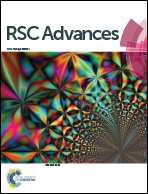A colorimetric and turn-on fluorescent chemosensor for selective detection of Hg2+: theoretical studies and intracellular applications†
Abstract
A new colorimetric, “turn-on” fluorescent chemosensor (DEAS-BPH) was synthesized for selective and sensitive recognition of Hg2+ ions with no interference from environmentally relevant metal ions in a mixed organo-aqueous medium. It was found that the presence of mercury induced nearly 27-fold fluorescence enhancement. This was attributed to the 1 : 2 metal–ligand complexation, ascertained by a Job's plot, NMR titration and HRMS studies. A theoretical study was conducted to rationalize the colorimetric sensing behaviour of the probe on the basis of an intramolecular charge transfer (ICT) mechanism. In addition, morphological alteration upon complexation with mercury was explored with the aid of Field Emission Scanning Electron Microscope (FESEM) measurement. Results of MTT assay and fluorescence microscopic studies unveiled that the probe is cell permeable with low cytotoxicity. Furthermore, the reversibility of the sensor and its efficacy to function in a wide range of pH values designated the suitability to image intracellular Hg2+ ions in living HepG2 and Escherichia coli bacterial cells.


 Please wait while we load your content...
Please wait while we load your content...